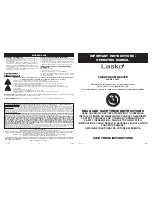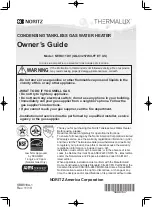
Secondary Cir
c
uit
Installation
8
4
Secondary Circuit Installation
4.1 Discharge Pipe Arrangement
Figure 4-1:
Typical discharge pipe arrangement
Safety device ( e.g.
temperature relief valve)
Metal
discharge
pipe from
temperature
Metal discharge pipe from tundish
with continuous fall. See table and
worked example on next page
discharged below
fixed grating
Fixed grating
Trapped gully
Tundish
600mm max
300mm min
4.3 Worked Example
The example below is for a
1
/
2
”diameter
temperature relief valve with a
discharge pipe (D2) having 4 elbows
and a length of 7 m from the tundish to
the point of discharge.
From
Maximum resistance allowed for a
straight length of Ø22mm copper
discharge pipe (D2) from a
1
/
2
” diameter
temperature relief valve is - 9.0m.
Subtract the resistance for quantity of 4
Ø22mm elbows at 0.8m each = 3.2m.
Therefore, the maximum permitted
length equates to 5.8m.
5.8m is less than the actual length of
7m; therefore calculate the next largest
size.
Maximum resistance allowed for a
straight length of Ø28mm-pipe (D2)
from a
1
/
2
” diameter temperature relief
valve equates to - 18m.
Subtract the resistance for a quantity of
4 Ø28mm elbows at 1.0 each = 4m.
Therefore the maximum permitted
length equates to 14m.
As the actual length is 7m, a Ø28mm
diameter copper pipe will be
satisfactory.
4.2 Discharge Pipe Sizing
Max resistance allowed,
Minimum size of
expressed as a length
Resistance created
Valve outlet size,
Minimum size of
discharge pipe D2 from
of straight pipe, i.e. no
by each elbow or
diameter (inches)
discharge pipe D1 (mm)
tundish in (mm)
elbows or bends
bend in (m)
22
Up to 9
0.8
1
/
2
15
28
Up to 18
1.0
35
Up to 27
1.4
28
Up to 9
1.0
3
/
4
22
35
Up to 18
1.4
42
Up to 27
1.7
35
Up to 9
1.4
1
28
42
Up to 18
1.7
54
Up to 27
2.3









































